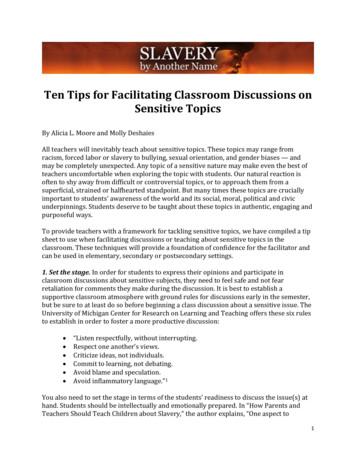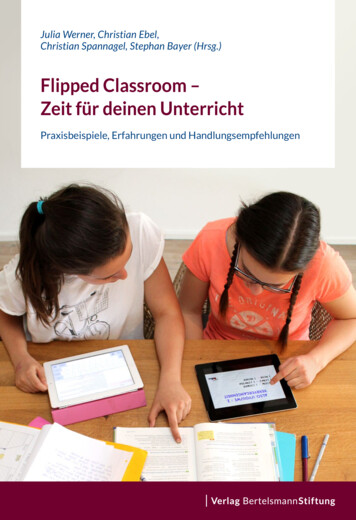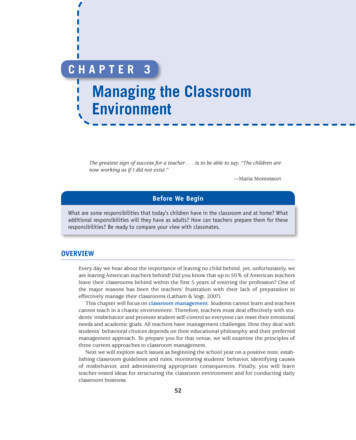
Transcription
Ten Tips for Facilitating Classroom Discussions onSensitive TopicsBy Alicia L. Moore and Molly DeshaiesAll teachers will inevitably teach about sensitive topics. These topics may range fromracism, forced labor or slavery to bullying, sexual orientation, and gender biases — andmay be completely unexpected. Any topic of a sensitive nature may make even the best ofteachers uncomfortable when exploring the topic with students. Our natural reaction isoften to shy away from difficult or controversial topics, or to approach them from asuperficial, strained or halfhearted standpoint. But many times these topics are cruciallyimportant to students’ awareness of the world and its social, moral, political and civicunderpinnings. Students deserve to be taught about these topics in authentic, engaging andpurposeful ways.To provide teachers with a framework for tackling sensitive topics, we have compiled a tipsheet to use when facilitating discussions or teaching about sensitive topics in theclassroom. These techniques will provide a foundation of confidence for the facilitator andcan be used in elementary, secondary or postsecondary settings.1. Set the stage. In order for students to express their opinions and participate inclassroom discussions about sensitive subjects, they need to feel safe and not fearretaliation for comments they make during the discussion. It is best to establish asupportive classroom atmosphere with ground rules for discussions early in the semester,but be sure to at least do so before beginning a class discussion about a sensitive issue. TheUniversity of Michigan Center for Research on Learning and Teaching offers these six rulesto establish in order to foster a more productive discussion: “Listen respectfully, without interrupting.Respect one another’s views.Criticize ideas, not individuals.Commit to learning, not debating.Avoid blame and speculation.Avoid inflammatory language.”1You also need to set the stage in terms of the students’ readiness to discuss the issue(s) athand. Students should be intellectually and emotionally prepared. In “How Parents andTeachers Should Teach Children about Slavery,” the author explains, “One aspect to1
consider involves presenting prerequisite concepts, knowledge, and skills within the SocialStudies that prepare students for the information. This entails a careful examination ofwhat is developmentally and age appropriate and involves an understanding of how tobe responsive to, and sensitive of, all children within the classroom community.” 22. Know yourself. Before facilitating a discussion about possibly sensitive topics, it isimportant that you consider your own biases or confusion surrounding the issue.3 Howhave you come to know what you know or think what you think? Why have you valuedsome information or sources over others? When seeking to help students understandothers or study historically sensitive topics, it is important to discuss the concepts ofempathy and perspective. We are all products of our society and culture, and attitudes andvalues change. Discussing a moment when your own ideas changed may help model theopen-mindedness and conscientious self-reflection that you hope to inspire.43. Recognize the diversity of your students. It is important to remember that each of thestudents in your classroom comes from a unique background (regardless of race) and hashad different experiences. See this diversity as an asset. Authentic opportunities forlearning happen when students are exposed to many different perspectives. Give studentsthe opportunity to express their views and make it your goal to understand, value andrespect the backgrounds and experiences that formed them.5 Teach your students to do thesame.4. Set a framework and objective for the discussion. To get the most out of yourdiscussion, when possible state an objective for the discussion that connects to thecurriculum or standards. Also establish a framework for the discussion with a specificfocus. This will keep the students on task and ensure that your goals for the discussion aremet.6 Also keep in mind that a static objective for these discussions should be based uponproviding students with opportunities to “engage in experiences that develop fairmindedness, and encourage recognition and serious consideration of opposing points ofview, respect for well-supported positions, sensitivity to cultural similarities anddifferences, and a commitment to individual and social responsibility.”75. Provide a common base for understanding. The Center for Research on Learning andTeaching at the University of Michigan suggests assigning readings or showing a video clipabout a particular conflict or topic to prompt discussion. Using materials that provide acontext for examining diverse perspectives allow students to gain an awareness of others’views, and offer students a framework in which to expand their knowledge aboutconflicting positions they might otherwise disregard. Like having a set objective andframework, these complementary materials will help focus the discussion.86. Be an active facilitator. As the teacher you should neither dominate the discussion norpassively observe. Your role as the teacher should include intervening in the discussion to: Provide reminders about respecting the right of others to have differingopinions,2
re-word questions posed by students,correct misinformation,ask for clarification,review the main points, andmake reference to relevant reading materials or course content.97. Foster civility. There is a good chance that discussions about sensitive topics maybecome heated. The main goal of fostering civility is to protect your students from feelingpersonally attacked. Make sure students understand that it is okay to disagree, but keepcomments focused on the ideas and not the people who share their ideas.108. Be prepared to deal with tense or emotional moments. When discussing sensitiveissues or difficult topics, it is very possible that some students will get angry or upset. If thishappens, remain calm and try to turn it into a learning experience. Don’t avoid the issue,but do defer it until you make a plan for dealing with it if necessary.119. Summarize. At the end of the discussion, summarize the main points. You can also askstudents for quick written feedback about the discussion, which you can discuss during thenext class.12 Allowing students to summarize provides opportunities for student to recall,review and reflect upon the content of the discussion.10. Reflect. Reflecting plays a key role in two ways. First, encourage students to activelyreflect on the comments made by other students, especially those they may disagree with.Second, leave time after the discussion for students to record their reflections in writing.This time will allow quieter students an opportunity to respond privately to the instructor,and allow everyone a chance to unwind and think calmly about his or her views on theissue.13 Ask students to think about whether there are new ideas, opinions or opportunitiesfor further discussions, awareness and reflection. Use their responses to develop extensionactivities that will build community and support differing viewpoints.3
S.E.N.S.I.T.I.V.E ACROSTICEvery teacher will inevitably face a moment in the classroom when a sensitive topic,situation or event arises. You can never be sure of when these topics will come up, but youcan prepare yourself. Use the following tips to guide the way you facilitatediscussions surrounding sensitive topics .Set the stage for difficult conversations by assessing student readiness based on realistic,non-biased expectations. Set the stage by creating a supportive environment based onrespect. Provide a framework that sets objectives connected to the curriculum whenpossible.Enable and facilitate the discussion of ideas, not people. The teacher must support studentsand enhance their opportunities to grow in the discussion. The facilitator providesguidelines for safe, productive and respectful discussions and for interventions such asdispelling myths, helping students make curricular connections and clarifying students’contributions to the conversation. Taking this role seriously can be the difference betweena successful or unsuccessful conversation.Never allow your personal biases and opinions to influence the facts or get in the way ofopportunities for students to examine diverse perspectives. Know your biases and beaware of their impact on your thoughts, attitudes and behaviors related to teaching.Seek out age- and grade-level appropriate digital media, readings and other materials thatallow students to begin with baseline knowledge and that will be the basis of discussions.Identify materials that show students to “see both sides”: illustrate diverse perspectivesand provide students with opportunities to analyze, synthesize and evaluate contentdiscussed.Interpersonal classroom activities that involve discussing sensitive or controversial issuesshould be complemented with intrapersonal activities like self-reflection and personalawareness. Allowing the students to have time to reflect on their feelings, conscious andunconscious thoughts, and any new learning provides enhanced opportunities for growth.Seek feedback from students to inform your instructional decisions about upcominglessons.The act of summarizing conversations, either orally or in writing, provides students with achance to recall new or interesting information, and review what was said and how it fits orconflicts with personally held thoughts and opinions. Summarization serves as afoundation for possible subsequent actions such as making personal changes, examiningnew perspectives, or learning to respect and value the diverse perspectives of others.Invite disagreement. Encourage students to speak up with different opinions — while stillmaintaining decorum. It is up to you to foster and maintain civility in your classroom and to4
help students understand the guidelines for discussing difficult ideas. One way to viewcivility is through the lens of the Golden Rule: Do unto others as you would have them dounto you. Remind students that we all have the right to agree or disagree with others’perspectives on sensitive topics.Value the diversity of your students as an asset. Teach your students to do the same. Youractions affect the culture and climate of your classroom. In a classroom that truly values thecontributions and differences of all students, authentic opportunities for teaching andlearning are nurtured and embraced by all stakeholders.Emotional and tense moments may arise during discussions about sensitive issues. Beprepared to help students work through them. Acknowledge that there may be times whenthey feel uncomfortable talking about the issue. Speak to this discomfort and share yourpersonal thoughts and feelings about discomfort you may feel.About the Authors:Alicia Moore is Associate Professor, Southwestern University and Molly Deshaies is anElementary Education major, Southwestern University.5
Notes:1.2.3.4.5.6.7.8.9.10.11.12.13.Center for Research on Learning and Teaching, University of Michigan (2011).Guidelines for discussion of racial conflict and the language of hate, bias, anddiscrimination. s.php(accessed October 19, 2011).Pearson, K. (2011, April 19). How parents and teachers should teach children aboutslavery. ould-teachchildren-about-slavery (accessed October 19, 2011).National Council for the Social Studies, 2008. A Vision of Powerful Teaching andLearning in the Social Studies: Building Social Understanding and Civic werful (accessed October 17, 2011).The Center for Teaching and Faculty Development, San Francisco State University(n.d.). Top ten tips for addressing sensitive topics and maintaining civility in theclassroom. -the-classroom.htm (accessed October 17, 2011).Ibid.Center for Research on Learning and Teaching, University of Michigan. (2011).Guidelines for discussion of racial conflict and the language of hate, bias, anddiscrimination. s.php (accessedOctober 19, 2011).National Council for the Social Studies, 2008. A Vision of Powerful Teaching andLearning.Center for Research on Learning and Teaching, University of Michigan, Guidelines fordiscussion.Ibid.The Center for Teaching and Faculty Development, San Francisco State University,Top ten tips.Warren, L., & Bok Center, D. (2000). Managing hot moments in the pic58474/hotmoments.html (accessedOctober 17, 2011).Center for Research on Learning and Teaching, University of Michigan. (2011).Guidelines for discussion of racial conflict and the language of hate, bias, anddiscrimination. s.php (accessedOctober 19, 2011).The Center for Teaching and Faculty Development, San Francisco State University(n.d.). Top ten tips for addressing sensitive topics and maintaining civility in theclassroom. -the-classroom.htm (accessed October 17, 2011).Resources:1.Neal, L. I., Moore, A. L. (2003). When bad things happen to good people: Humanrights at the core. Social Studies and the Young Learner, 15(3), /scholarship/WhenBadThingsHappen.pdf6
2.3.4.5.6.7.It's not so black and white: Discussing racial issues can make students and teachersuncomfortable, Beverly Daniel tx2019s-not-so-black-amp-whiteTeaching Young Children About Slavery Using Literature, Judith Y. Singer:http://people.hofstra.edu/alan j terature.pdfSlavery and the Making of America: http://www.pbs.org/wnet/slavery/Association for the Study of African American Life and History Black HistoryBulletin: African Americans and the Civil War; Volume 73, No. 2.Tackling Tough Topics: amaster-teacher/23901Difficult Situations, Vanderbilt University’s Center for Teaching (CFT) eractions/difficult-situations/ 2012 Twin Cities Public Television, Inc.7
Ten Tips for Facilitating Classroom Discussions on Sensitive Topics By Alicia L. Moore and Molly Deshaies All teachers will inevitably teach about sensitive topics. These topics may range from racism, forced labor or slavery to bullying, sexual orientati










